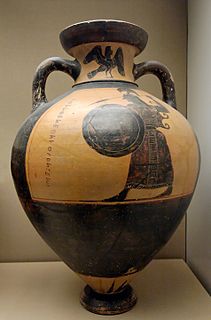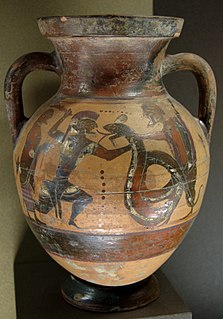
An amphora is a type of container with a pointed bottom and characteristic shape and size which fit tightly against each other in storage rooms and packages, tied together with rope and delivered by land or sea. The size and shape have been determined from at least as early as the Neolithic Period. Amphorae were used in vast numbers for the transport and storage of various products, both liquid and dry, but mostly for wine. They are most often ceramic, but examples in metals and other materials have been found. Versions of the amphorae were one of many shapes used in Ancient Greek vase painting.

Black-figure pottery painting, also known as the black-figure style or black-figure ceramic, is one of the styles of painting on antique Greek vases. It was especially common between the 7th and 5th centuries BCE, although there are specimens dating as late as the 2nd century BCE. Stylistically it can be distinguished from the preceding orientalizing period and the subsequent red-figure pottery style.

Red-figure vase painting is one of the most important styles of figural Greek vase painting.

Sophilos was an Attic potter and vase painter in the black-figure style. Sophilos is the oldest Attic vase painter so far to be known by his true name. Fragments of two wine basins (dinoi) in Athens are signed by him, indicating that he both potted and painted them. In total, 37 vessels are ascribed to him, mostly amphorae, dinoi, kraters, as well as three pinakes. Apart from his work for the domestic market, he was also one of the masters of major significance in the process of supplanting the dominance of Corinthian vase painting in the markets of Etruria, and Southern Italy, the most important export area for Greek vases. His works were exported as far as the Black Sea region, Syria and Egypt (Naukratis).

Psiax was an Attic vase painter of the transitional period between the black-figure and red-figure styles. His works date to circa 525 to 505 BC and comprise about 60 surviving vases, two of which bear his signature. Initially he was allocated the name "Menon Painter" by John Beazley. Only later was it realised that the artist was identical with the painters signing as "Psiax".

Panathenaic amphorae were the amphorae, large ceramic vessels, that contained the olive oil given as prizes in the Panathenaic Games. Some were ten imperial gallons and 60–70 cm (24–28 in) high. This oil came from the sacred grove of Athena at Akademia. The amphorae which held it had the distinctive form of tight handles, narrow neck and feet, and they were decorated with consistent symbols, in a standard form using the black figure technique, and continued to be so, long after the black figure style had fallen out of fashion. Some Panathenaic amphorae depicted Athena Promachos, goddess of war, advancing between columns brandishing a spear and wearing the aegis, and next to her the inscription τῶν Ἀθήνηθεν ἄθλων "(one) of the prizes from Athens". On the back of the vase was a representation of the event for which it was an award. Sometimes roosters are depicted perched on top of the columns. The significance of the roosters remains a mystery. Later amphorae also had that year's archon's name written on it making finds of those vases archaeologically important.

The Darius Painter was an Apulian vase painter and the most eminent representative at the end of the "Ornate Style" in South Italian red-figure vase painting. His works were produced between 340 and 320 BC.

Burgon Group is the conventional name given to a group of Attic black-figure vase painters active in the middle third of the sixth century BC.

Group E was a group of Attic vase painters of the black-figure style. They were active between 560 and 540 BC.
Elbows Out is the name given to an Attic black-figure vase painter, active in Athens around 550/540 to 520 BC. His conventional name is derived from the strongly exaggerated gestures and odd anatomy of his dancing figures. Together with the Affecter, he is considered one of the Mannerists of the black-figure style. He painted e.g. lip cups and neck amphorae, the latter in a special shape with a heavy ovoid body. His amphorae are decorated with several friezes. His band cups resemble works by Tleson and Lydos, but are more conventional in terms of the animal motifs. He also painted a lydion, a vase shape very rarely produced by Attic potters. He is often seen as connected with the Affecter, but also with the Amasis Painter. The link with the latter should not be overestimated.

The Lysippides Painter was an Attic vase painter in the black-figure style. He was active around 530 to 510 BC. His conventional name comes from a kalos inscription on a vase in the British Museum attributed to him; his real name is not known.

Boeotian vase painting was a regional style of ancient Greek vase painting. Since the Geometric period, and up to the 4th century BC, the region of Boeotia produced vases with ornamental and figural painted decoration, usually of lesser quality than the vase paintings from other areas.

Euboean vase painting was a regional style of ancient Greek vase painting, prevalent on the island of Euboea.

The Pontic Group is a sub-style of Etruscan black-figure vase painting.

Pseudo-Chalcidian vase painting is an important style of black-figure Greek vase painting, dating to the 6th century BC.
Cycladic vase painting was a regional style of Greek vase painting, produced in the Cycladic islands.

Ionic vase painting was regional style of ancient Greek vase painting.

Campanian vase painting is one of the five regional styles of South Italian red-figure vase painting. It forms a close stylistic community with Apulian vase painting.

Paestan vase painting was a style of vase painting associated with Paestum, a Campanian city in Italy founded by Greek colonists. Paestan vase painting is one of five regional styles of South Italian red-figure vase painting.

The Northampton Sekhemka statue is an ancient Egyptian artefact, given by the Marquess of Northampton to Northampton Museum, in or about 1870. The statue dates from the 5th dynasty and depicts Sekhemka the scribe with his wife, Sitmerit. It was the subject of a controversial sale in July 2014, that raised questions of the museum's ownership and the ethics of selling artefacts. The statue was sold to an unidentified buyer for £15.76m, which broke the world record for Ancient Egyptian art at auction. On 1 August 2014, Northampton Museums had their accreditation removed by Arts Council England, which ruled that the sale did not meet the accredited standards for museums in managing their collections.



















